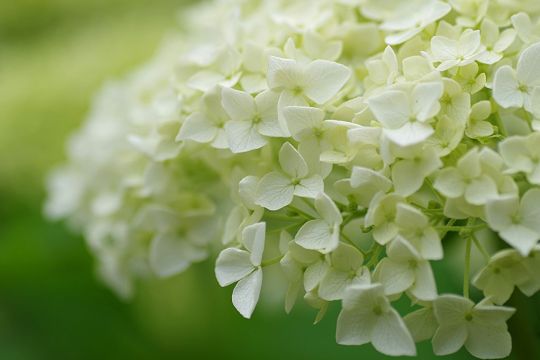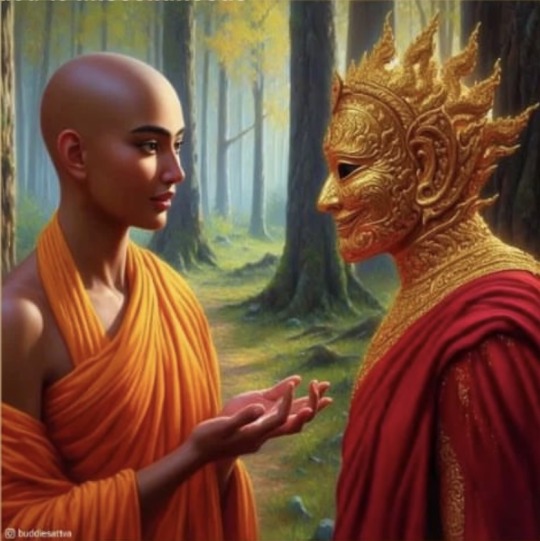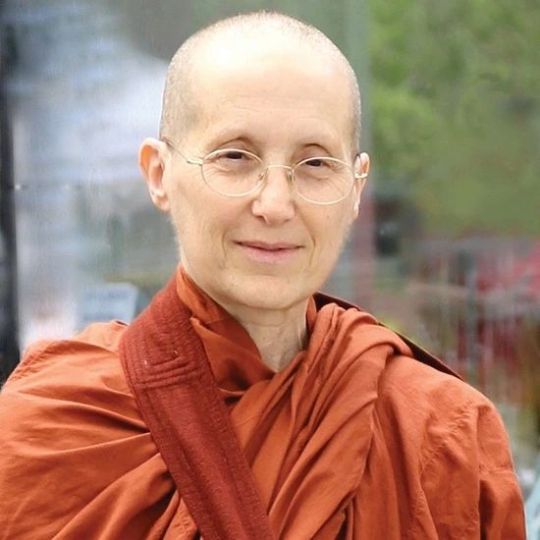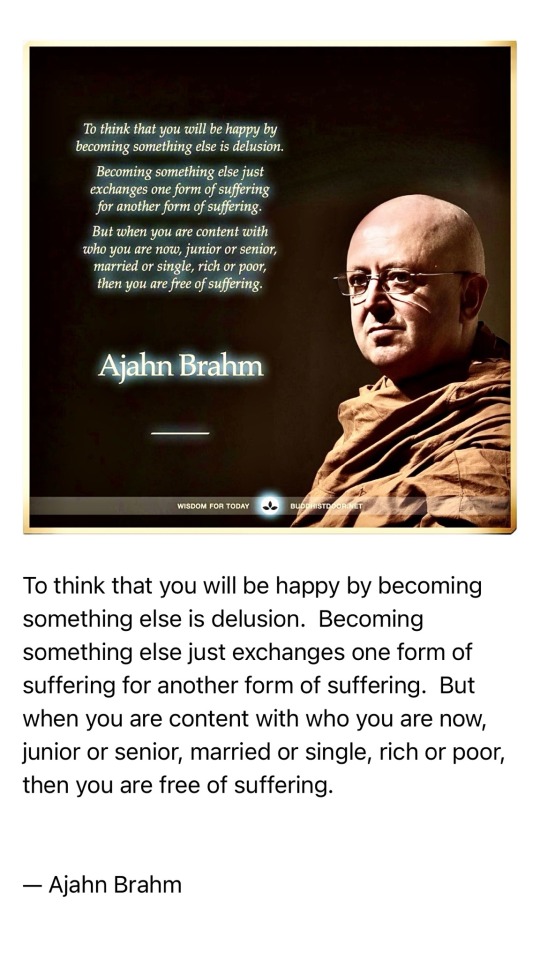#bhikkhuni
Photo

The Quest for Buddhism (90)
Early Buddhism and the disciples
Ten Principal Disciples No. 10: Ananda - Leading figure in establishing the nun's order [So far]
Most importantly, the early texts attribute the inclusion of women in the early sangha(monastic order)to Ananda.
Ananda has an crutial role in establishing the order of bhikkhunis (nuns), as he requested the Buddha on behalf of the foster-mother of Buddha, Mahapajapati Gotami (Ref), and other Sakya (Ref1) women, including Buddha's former wife Yashodhara (Ref2),when they were ordained, to allow them to be ordained.
According to the texts, Ananda's role in founding the bhikkhuni order made him popular with the bhikkhuni community.
Ananda was attractive in appearance. However, it gave him a hard time that because of his good looks and tenderness, Ananda often suffered from troubles with women.
A Pali account related that a bhikkhuni (nun) became enamored with Ananda, and pretended to be ill to have Ananda visit her. When she realized the error of her ways, she confessed her mistakes to Ananda. Other accounts relate that a low-caste woman called Prakrti fell in love with Ananda, and persuaded her mother Matangi to use a black magic spell to enchant him. This succeeded, and Ananda was lured into her house, but came to his senses and called upon the help of the Buddha. The Buddha then taught Prakrti to reflect on the repulsive qualities of the human body, and eventually Prakrti was ordained as a bhikkhuni, giving up her attachment for Ananda.
Ananda is one of the most loved figures in Buddhism. He was known for his memory, erudition and compassion, and was often praised by the Buddha for these matters. However, he still had worldly attachments, and he lacked the ability to regulate his mind and was not able to achieve the same degree of clarity and wisdom, so at the time of the Buddha's death, he had not attained arhat yet.

仏教の探求 (90)
初期仏教と弟子たち
十大弟子その十: 阿難 (あなん、梵/巴:アーナンダ・阿難陀) 〜尼僧教団設立の貢献者(これまで)
最も重要なことは、初期のサンガ(僧団)に女性が含まれるようになったのは、アーナンダの功績であるとすることである。
アーナンダは、ブッダの養母・摩訶波闍波提(まか・はじゃはだい、梵:マハープラジャーパティー参照)をはじめ、ブッダの前妻ヤショーダラー(参照2)を含む他の釈迦族(梵:シャーキヤ・参照1)の女性たちが出家する際、彼女たちの代理として釈迦に出家を願い、比丘尼 (びくに: 尼僧)階級の確立において重要な役割を担っている。
教典によれば、アーナンダは尼僧教団の創設に貢献し、尼僧社会の中で人気を博したという。
アーナンダは魅力的な外見をしていた。しかし、アーナンダはその美貌と優しさがために、たびたび女難に見舞われ苦しんだ。パーリ語の記述によると、ある比丘尼 (びくに: 尼僧)がアーナンダに夢中になり、病気のふりをしてアーナンダに見舞ってもらったという話がある。彼女は自分の過ちに気づき、アーナンダに自分の過ちを告白した。また、プラクリティという下層階級の女性がアーナンダに恋をして、彼女の母親マタンギに黒魔術を使ってアーナンダを魅惑するように説得したという記述もある。これは成功し、アーナンダは彼女の家に誘い込まれたが、正気に戻ってブッダの助けを求めた。ブッダはに人体の反発的な性質について反省するように教え、やがてプラクティは出家して、アーナンダへの執着を捨て、尼僧になった。
アーナンダは、仏教の中で最も愛された人物の一人である。記憶力、博識、慈悲深さなどで知られ、ブッダからしばしば褒め称えられた。しかし、彼はまだ世俗的な執着を持ち、心を摂する点に欠け、定と慧が均等でなく、漏尽通を起くことができず、仏の入滅時には未だ有学の人で阿羅漢果を得ていなかったと言われる。
#ananda#establish nun's order#buddha#buddhism#history#nature#art#ten principal disciples#a popular disciple
86 notes
·
View notes
Text
Intersexism in Korean history
Im Seong-gu
Im Seong-gu (임성구지) was a Korean intersex person from the early Joseon period (1392–1897), whose life is recorded in the Veritable Records of the Joseon Dynasty.
Biography
The dates of Im Seong-gu's life are unknown, but part of it is recorded in the Veritable Records of the Joseon Dynasty, in Book 8 - the Veritable Records of Seonjo (Revised). In the annals, Im Seong-gu is referred to as a "man from Gilju", who married a man and a woman. It also discusses how they were full of both ying and yang, which expressed itself through their gender. They were brought up as a girl, married, but the husband was shocked to see their body on the wedding night. They later re-married to a woman.
In 1548, the Joseon court decided that Im Seong-gu was disturbing society and exiled them. The Saganwon (사간원), the opposition to the monarchy, insisted that Im Seong-gu should be executed. However King Myeongjong of Joseon forbade execution, stating that exile was enough. The annals discuss whether they should be killed, like other similar people in India. They also describes how Im Seong-gu wore men's and women's clothes.
Historiography
An alternative interpretation of the Veritable Records describes Im Seong-gu as a bisexual man.
Sa Bangji
Sa Bangji (사방지, 舍方知) was a Korean intersex person during the Joseon Dynasty (1392–1897).
Biography
Sa Bangji had hypospadias and reared as a feminine gender role. Sa learned sewing from their mother. Sa Bangji had sexual relationships with widows and Bhikkhunis [a fully ordained female in Buddhist monasticism]. In 1462, the Veritable Records of the Joseon Dynasty recorded that Sa Bangji, a slave, had an affair with a widowed noblewoman.
Cultural depictions
A film based on Bangji's life was produced in South Korea in 1988 named Sa Bangji.
21 notes
·
View notes
Text
Submitted via Google Form: Follow Up to Ungendering Religious Words
Very interesting. Thank you for your answer regarding religous words. I have to ask this because I find it quite curious you immediately went to Catholicism and Western culture and only that. Why? Solely because of word origin and Greeks were mostly Catholic?
It is totally valid as I just found out that 'monk' is also used in Catholicism as well, but until now, I never heard that 'monk' was used outside of East Asian religions. For Western religions I always heard words more like 'priest' even if that doesn't specifically describe the hermit types, or even 'eremite' a couple times. So that really threw me.
My fictional religion definitely takes a lot more inspiration from East Asian religions. I am Asian American and Buddhist but I grew up in Asia since my teens. I do have some relatives who are Christian-no denomination-but they never associated monk with anything closer to Christianity either. That is one reason thus I very much landed on the word 'monk' as I wanted context to land in this direction.
A made up word is great, but it also wouldn't land anywhere in context and I don't want to immediately dump paragraphs of world-building describing the religion. Or maybe if I do write it well, people can pick that up from other brief context, whereas you had absolutely none. Perhaps that's a writing issue rather than world-building though...?
Feral: Indeed, monastic orders are pretty common the world over. And if you’re writing in English and want to refer to your monastic clergy in English, Tex’s etymology lesson and how the word has developed in English and Licorice’s advice on finding other English words is true and relevant regardless of the inspiration.
While most folks, especially fantasy fans, from Western countries will be more or less equally exposed to “monk” referring to Western and Eastern traditions, nearly anyone in the English speaking world without a personal cultural tie to Eastern traditions will default to “nun” in reference to Catholicism or Anglicism (or maybe Orthodoxy) depending on where they live if there isn’t any preface or context, eg. “Buddhist nun.” This is very important cultural context for you to be aware of if you’re trying to have the broadest possible English-speaking audience.
Now you don’t mention your ethnicity or where in Asia you live, so forgive me if I use the wrong language, but hopefully, you’ll still understand my meaning. If you’re not drawing inspiration from Christian/Western monks and nuns and instead are drawing inspiration from bhikkhu and bhikkhuni, you could use the term most appropriate to your world’s specific cultural inspiration. I certainly couldn’t give you advice on ungendering the terms, but it might be a good starting place - either use the term that’s most correct to the religion you are worldbuilding or conlang a name using the real world term as a jumping off point.
Using an unfamiliar term absolutely does not need paragraphs of explanation - a single dashed off phrase like this one - or just context will tell your audience what they need to know when you introduce the word. As you guessed, though, that is a question of writing and not of worldbuilding.
Ebonwing: If you don’t want to make up an entirely new word, then you could just repurpose an existing gender-neutral English word that doesn’t ordinarily have religious connotations and show through context that that’s what it means here. For example, if you wanted to name your monk/nun equivalent Servants, you could introduce the Servants tending to a temple or doing other things that fit into your religion.
12 notes
·
View notes
Text
i used to be a horribly zealous fuckface who wanted to become a bhikkhuni and work towards the goal of making sure everyone was freed from samsara (read: became buddhist). and while i do not miss this time at all as it was awful i will admit that i do sometimes miss the like. ZEST. of group religious practice. there's like a word for it in anthropology that is escaping me right now but like there is just some shit that goes on when you're all chanting together or all sincerely listening to the monks recite the suttas. there's a secret sauce and it's a hell of a feeling.
5 notes
·
View notes
Text

Mãra:
That state so hard to achieve, which is to be attained by the seers, can't be attained by a woman with her two-fingered wisdom.
Bhikkhuni Soma:
What difference does womanhood make when the mind is serene & knowledge is present as one sees correctly into the Dhamma?
Soma Sutta, SN 5.2
2 notes
·
View notes
Photo

Look to Your Heart If we study our own hearts, we’ll find that everything is written there. — Ayya Medhanandi Bhikkhuni, “The Dharma of Snow” (at New Haven Zen Center) https://www.instagram.com/p/CicZVEQuM_t/?igshid=NGJjMDIxMWI=
14 notes
·
View notes
Text
realized that my ex-girlfriend might be emotionally abusing me
During the relationship she told me that she planned to find a buddhist temple to become a bhikkhuni
She asked me to give up my study and chat with her every night because she was suffering from depression and bipolar syndrome
After I tried to empathize with her, she told me she didn't need me anymore on the grounds that I was exhibiting symptoms of depression
She asked me to agree with her on the grounds that I was a STEM student and had a lower degree than her.
I'm not trying to blame her, I'm just curious as to why I chose to be abused by her when I was free to leave.
It's a question similar to why nazism arose in a democracy
2 notes
·
View notes
Photo

@strawes @poopy-poop-poo @remyeel @fleurpure @wiselyv @nemnuong @tonyvino @snootfruit @bhikkhuni-blog @simpliie @moodycrissy @sehjei @s-rinn @storments @p-s-y-c-h-i-c-ganesha @mczarts @cacti-lxve @statiqque @oh-lord-jesus-itsafire @parvd0x0
OK GOOD
7 notes
·
View notes
Photo

Thilashin: Nun in Myanmar.
A thilashin "possessor of morality", from Pali sīla is a female renunciant in Burmese Buddhism; a Burmese Theravada Buddhist nun. They are not fully ordained nuns, as the full ordination is not legal for women in Burma (bhikkhuni), but are closer to sāmaṇerīs, 'novice nuns'. According to 2016 statistics published by the State Sangha Maha Nayaka Committee, there were 60,390 thilashin in Myanmar (Burma).
Like the Maechi of neighbouring Thailand and the dasa sil mata of Sri Lanka, thilashin occupy a position somewhere between that of an eight-precept lay follower and a fully ordained monastic. However, they are treated more favourably than maechi, being able to receive training, practice meditation and sit for the same qualification examinations as the monks.
Thilashins observe the ten precepts and can be recognized by their pink robes, shaven head, orange or brown shawl and metal alms bowl. Thilashins would also go out on alms round on uposatha days and receive uncooked rice or money.
Thilashins are addressed with the honorifics sayalay 'little teacher' and daw or dau. These are attached to the Buddhist name given.
Thilashins often reside in either separate quarters or in segregated kyaung (temple-monasteries). They do not have to look after the monks, but may help cook if required. Although ranked lower than the monks, they are not subservient to them, but form their own communities.
Thilashins are not fully ordained members of the Sangha. The full bhikkhuni lineage of Theravada Buddhism died out, being preserved only in the Mahayana tradition, and for various technical and social reasons was therefore absent, leaving the lay practice of living as a thilashin the only option for women who wish to renounce in Burma. As a result, in many respects the lifestyle of thilashins resembles that of an ordained bhikkhuni, even to the extent of making a daily alms-round.There have been efforts by some thilashins to reinstate the bhikkhuni lineage, although there are serious reservations and legal obstacles from the government, monks and general populace. A new Theravada bhikkhuni sangha was first convened in 1996, and since then many more have taken the full vows. However, in Myanmar, thilashins remain the only monastic option for women at this time and ordaining as a bhikkhuni is an offence punishable by imprisonment.
3 notes
·
View notes
Text
Ace Attorney fanfiction ideas led me on a very long spiral researching Japanese Buddhism and specifically trying to find the name of the head covering that a very select number of Buddhist nuns wear in Japanese media.
I found the answer on the Ōkami wiki after about an hour of frantic googling. It's an ama zukin (「尼頭巾」, "nun/bhikkhuni hood") and it is fucking impossible to find any information about it in English.
ADHD is a hell of a thing.
5 notes
·
View notes
Text
https://peacelilysite.com/2024/02/01/a-bhikkhuni-who-appears-once-in-a-century/
0 notes
Link
Such a one will perceive successively loftier stages of distinction
0 notes
Text

Phra Visuddhisamvarathera AM (Thai: พระวิสุทธิสังวรเถร), known as Ajahn Brahmavaṃso, or simply Ajahn Brahm (born Peter Betts on 7 August 1951), is a British-born Theravada Buddhist monk.
Currently, Ajahn Brahm is the abbot of Bodhinyana Monastery in Serpentine, Western Australia; Spiritual Director of the Buddhist Society of Western Australia (BSWA); Spiritual Adviser to the Buddhist Societies of Victoria and South Australia; Spiritual Patron of the Buddhist Fellowship and the Brahm Centre in Singapore; and Spiritual Adviser to the Anukampa Bhikkhuni Project in the UK.
•
•
🔔 Wisdom for Today - Buddhistdoor Global: Teachings from the world of Buddhism and beyond, updated each weekday:
☸️ BDG • Buddhist Door Global website:
•
#Buddhism#Theravāda Buddhism#Thai Forest Tradition of Theravāda Buddhism#Buddhism in Australia#Ajahn Brahm
0 notes
Text
anattā and artificial intelligence
The Buddhist concept of anattā appears in a thought window: “non-self” – no unchanging, permanent self or essence can be found in any phenomenon. And to begin with, there is the story of Vajira, a Buddhist nun (bhikkhuni), one of the earliest women adepts in Buddhist history.While Vajira was meditating, she was confronted by Mara, a malignant celestial demon king, and he asked about the origin…

View On WordPress
#anatta#anicca#awareness#Buddhism#conscious experience#letting go#loving-kindness#metta#mindfulness#non-duality
1 note
·
View note
Text

SPIRITUAL FRIEND IN THERAVADA BUDDHISM - 02
Spiritual friend (kalyana mitta)
"Kalyana mitta" in the Pali language, "kalyana" meaning lovely or beautiful and "mitta" meaning friend, is a spiritual friend who is of paramount importance to one's spiritual journey towards enlightenment. The meaning of "kalyana", lovely and beautiful, does not refer to one's physical attractiveness, but to the inner qualities of conviction, loving kindness, compassion, virtue, generosity, wisdom etc. In the English language kalyana mitta is also described as "admirable friend", "virtuous friend", "good friend", "benevolent friend" "ideal friend" and "noble friend".
Spiritual friendship (kalyana mittata) is equally beneficial to the disciples of the Buddha's doctrine, whether they are monastic or lay disciples, who may belong to any one of the four groups of Buddhist disciples.
& Four groups of Buddhist disciples
Buddhist monks (bhikkhu)
Buddhist nuns (bhikkhuni)
Male lay disciples (upasaka)
Female lay disciples (upasika)
Within a spiritual relationship, a disciple is naturally encouraged to maintain a moral and wholesome practice, learn from them and cultivate the good qualities of the spiritual friend.
The importance of spiritual friendship
In the Maha Mangala sutta in which the Buddha has described the great blessings in life which lead to one's material and spiritual success, the very first two factors are avoidance of the foolish people and association with the wise people.
"Asevana ca balanam, Panditanan ca sevana"
"Not to associate with the foolish, To associate with the wise"
Association with the wise people will provide the opportunity to listen to good advice, and to cultivate faith, clear thinking, moral conduct and eradication of the mental hindrances leading to wisdom and final liberation.
#buddha#buddhist#buddhism#dharma#sangha#mahayana#zen#milarepa#tibetan buddhism#thich nhat hanh#red tara#tantra#padmasambhava#avalokitesvara#amitabha#shantideva#dakini#Dzogchen#guru rinpoche#four noble truths#heart sutra#vajrasattva#bodhicitta#bodhisattva#rainbow body#meditation#mala#mantra#medicine buddha
4 notes
·
View notes
Photo

I had a direct encounter with Venerable Dhammananda Bhikkhuni last year, that came rushing back (in an unexpected way) with full force today -- catching me completely by surprise -- bringing me to laughter at first, and then to tears.
I am still sitting with tears streaming down my cheeks as I write this. I don’t have much to say about it -- other than, THANK YOU.
I’m sure the teaching and understanding will continue to unfold. More to come, maybe through words, or maybe simply through being.

Venerable Dhammananda Bhikkhuni is Thailand’s first fully ordained Theravada Buddhist female monk and abbess. She is the spiritual leader of Songdhammakalyani Temple located about an hour southwest of Bangkok. Venerable Dhammananda offers a unique perspective as both an ordained Theravada Bhikkhuni and a feminist, and has been internationally recognized for her work on women in Buddhism and environmental conservation. Prior to her ordination, she was an Associate Professor of Buddhist Studies at Thammasat University for 27 years. She is a tireless crusader for women’s ordination and has traveled the world speaking to audiences about the need to restore the “fourth pillar” of Buddhism.
0 notes